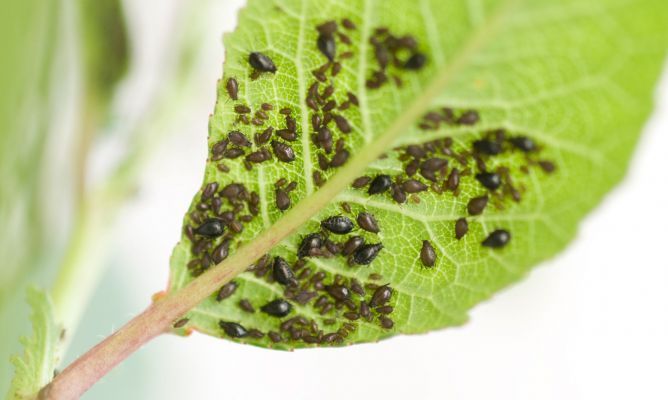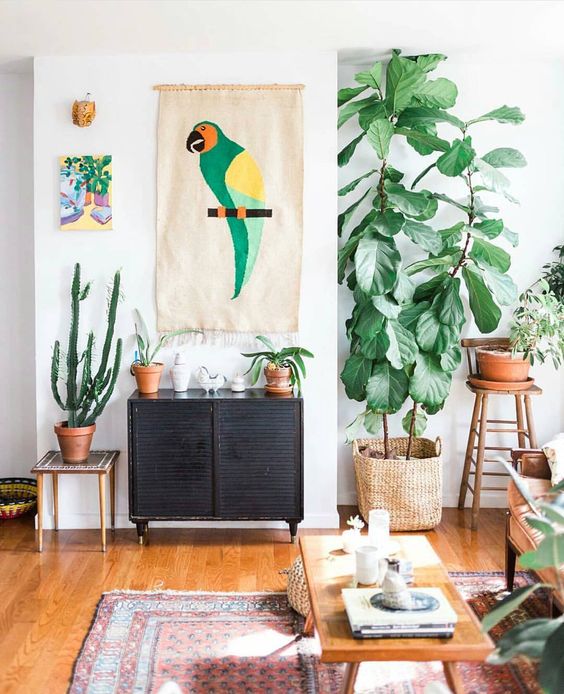The aphid or Aphids are a common pest in many plants. These pesky pear-shaped insects feed on plant sap, and large numbers can cause enormous damage to plants. In this article we will share with you all the information on how to get rid of aphids and how to identify them. This article also includes a special section on how to get rid of aphids on your roses.
What are aphids?
They are pear-shaped insects that feed on the sap of plants. They are about 1/8-inch long and can be green, yellow, red, black, or brown depending on their food source and species. Some adult aphids have wings.
They feed on groups of new plants, which can cause wilting or a yellowish tint to the plants. It can also prevent the plant from growing properly. Additionally, several species can transmit plant diseases during feeding.
They multiply quickly, so try to control them before playback begins. Many generations can occur in one season. The good news is that they tend to move quite slowly and aphids are relatively easy to kill naturally.
How to identify aphids?
Aphids are small (about 3mm long) and are often invisible to the naked eye. Various species can appear white, black, brown, gray, yellow, light green, or even pink. Some may have a waxy or woolly coating.
Here are some signs of aphid damage:
Look for misshapen, curled, stunted, or yellow leaves. Make sure to check the underside of the leaves as they love to hide there.
Look for leaves or stems that are covered in a sticky substance. This is a sign that they may have been drinking sap.
Honeydew, a sugary liquid produced by aphids as waste, can attract other insects, such as ants, which collect the substance for food. Honeydew can sometimes develop a fungal growth called sooty mold, causing the branches and leaves to appear black.
Look for distorted flowers or fruit. Aphids that feed on flowers or fruits can distort them.
How to get rid of aphids naturally?
Pesticides, herbicides, and insecticides have been linked to cancer, birth defects, autism, impaired brain function, and depression, just to name a few. If you are growing plants organically, you don’t want to treat the insects with any kind of chemicals. Luckily, there are several ways to keep aphids away from plants naturally.
1. Neem oil for aphids.
Neem oil is a vegetable oil obtained from the seed kernels of Neem trees. Neem oil is widely used in skin and hair care products, and as an insect repellent. It has a deep yellow color with a smell similar to that of garlic. Neem oil contains organic chemicals that act as insect repellants.
Neem oil not only repels aphids, but also repels mealy bugs, beetles, cabbage worms, ants, caterpillars, and miners. It can also be used to keep fungi from spreading to other plants in your garden.
Many commercial insecticides contain a refined extract of neem oil, but this is found alongside many other dubious ingredients that are harmful to the planet. You can use neem oil for your plants and here is a recipe for a natural neem oil insecticide:
- 2 tablespoons of neem oil with a tablespoon of Castile soap.
- Add the water as needed to a spray bottle and shake well.
- Spray on plants as needed.
2. Diatomaceous earth (DE)
Diatomaceous earth is a material made up of the fossils of small aquatic organisms known as diatoms. The skeletons of these tiny organisms have microscopically sharp edges that scrape off the protective covers of insects. DE, which is labeled food grade, is safe to use with pets and people and has little to no impact on the environment.
Before applying ED, you should put on a respiratory dust mask and safety glasses, as it is a fine dust that can irritate the respiratory tract if inhaled and cause eye irritation.
There are 2 ways to apply DE: a dry method and a wet method.
Dry method: The best time to apply DE is early in the morning or evening, when the plants are wet with dew, as the moisture helps the DE adhere to the plant. Alternatively, before applying the DE, use your hose to water the plants. Do this on all sides of the plant, including the underside of the leaves. Then sprinkle your plants while they are still wet and make sure to apply the DE to the underside of the leaves as well. Apply DE around the base of the plant to deter snails, slugs, and other crawling insects.
Wet method: Mix 4-5 tablespoons of DE in a 1-gallon jug of water and pour into a spray bottle. Spray the plants, including the underside of the leaves, until the plants are wet, but not dripping. Shake regularly to prevent the ED from sinking to the bottom of the spray bottle. Once the plants dry, they will have a thin, even layer of DE.
3. Physically remove the aphid.
If you’ve just noticed damage to your plants and the infestation is minor, you can physically remove the aphids. You will need a pair of gardening gloves and a brush.
Use the brush to scrape the insects off the leaves. You can also pluck them from the leaves and stems. Prune infected stems to prevent them from spreading to healthy plant parts. Make sure to drop the aphids in a bucket of soapy water as this will kill the aphids.
Another idea is to simply spray the aphids on the plants with the hose. They cannot fly and will not return to the plant.
Aphids can usually be physically removed from the plant. Once they fall to the ground, they are unlikely to re-stabilize on the plant because they are poor climbers and are likely to be eaten by other predators first.
4. Use water and natural soap to eliminate aphids from the plant.
You probably have a natural aphid remedy in your home right now. Hot soapy water can be used to eliminate light to moderate aphid infestations. These little insects have a waxy protective coating that dissolves once it touches the soapy water. This will dehydrate the insects and eventually kill them without harming the plant.
Start by diluting a few tablespoons of natural organic soap (like Castile soap) in a bucket of water. Use a spray bottle or sponge to apply the soapy water to the plant. Make sure to treat both sides of the leaves, as aphid eggs and larvae like to hide.
Like neem oil, soap and water also kill insects that are beneficial to plants. So be very careful when applying the mixture. Killing the ladybugs, wings, and floating flies will allow more aphids to take over.
Here’s another idea on how to use Castile soap with essential oils as a general bug repellent. You can use this Castile soap recipe to naturally repel insects like ants, spiders, cockroaches, and other creepy crawlers:
- 1/2 teaspoon of liquid castile soap.
- 2 cups of water.
- 10 drops of citronella essential oil.
- 10 drops of lemongrass essential oil.
Combine all ingredients in a spray bottle and shake before each use. You can also add a few drops of peppermint essential oil to this mixture. Spiders especially hate that.
5. Use Epsom salt to get rid of aphids.
Epsom salts can be extremely beneficial for your plants. Epsom salt can also help you get rid of aphids.
You can add 1/4 cup of Epsom salt to the above mixture and sprinkle it on the plant, even on the underside of the leaves, in the late afternoon or evening. The next morning, rinse the tops of the leaves to prevent the sun from burning them and the leaves falling off.
You can use this on roses, oranges, and grapes, and even your tomatoes. This will also kill most of the black smut fungi that grow on aphid honeydew.
6. Introduce beneficial insects.
If you don’t want to treat your plants with anything, you can protect them by introducing proactive insects.
Ladybugs and ladybird beetles are some of the best-known beneficial insects. They can be purchased in bulk at most garden stores.
Green wings and floating fly larvae are also beneficial because they have been known to eat aphids. You can buy lace eggs, but wild flies should be naturally attracted to the plant with fennel, caraway, or parsley.
In addition to introducing helpful insects to your garden, you can try planting herbs like garlic, oregano, and catnip (catnip is also one of the best plants to repel mosquitoes). The scents of these plants attract beneficial insects. Herbs like mint, dill, fennel, yarrow, and clover can be used to naturally attract ear flaps and ladybugs.
Another technique is to attract kinglets, titmouse, and chicks to your yard, which are known to eat aphids and other pesky insects. Since these birds’ nest in small trees and other places that provide good cover, you can attract them to your garden by planting hydrangeas, abelia, and other shrubs with dense foliage nearby.
7. Take the ants away.
Because ants feed on the honeydew secreted by aphids, they will protect aphid colonies from predators such as birds. If you can naturally keep ants out of your yard, birds and other insects will have a better chance of eating aphids.
You can naturally keep ants out of your yard by tying natural ant deterrents around the base. Ants don’t like the smell of mint or cinnamon. Sprinkle cinnamon around the base of the aphid-infected plant to prevent the ants from protecting them.
8. Choose disease resistant plants.
To limit the possibility of spreading disease and infection throughout the garden, choose plants that are resistant to disease. Although there are very few options, most garden stores should be able to tell you which plants are resistant to disease and aphids. Some examples may include geraniums, marigolds, and alliums.
9. Feed your plants with organic fertilizers.
The aphid is attracted to plants with high nitrogen levels and smooth new growth, which is due to over fertilization and excessive watering. Organic fertilizers are the best as they release nutrients slowly.
10. Grow a fake garden to distract aphids.
You can lure aphids away from your actual garden by planting a garden designed just for them. This will prevent them from being happily distracted from your real garden. Aphids love the following plants:
- Nasturtium.
- Aster.
- Cosmos.
- Mum.
- Larkspur.
- Hollyhock.
- Tuberous begonia.
- Dahlia.
- Zinnia.
- Verbena.
Also, make sure you don’t plant any of the plants mentioned above in the garden where you want the aphids to be kept outside.
How to get rid of aphids or rose aphids.
All types of aphids like roses, especially the main attacking rose aphids, rose aphids. There are several species of rose aphids, but the most common is generally Macrosiphum rosae. Signs of rose aphid infestation often appear in the early spring and summer months.
Some aphids can also carry the rose mosaic virus, which causes discoloration and spots on rose leaves.
Signs of infestation include curled, sticky, or disfigured rose leaves and flower buds and leaves that are tanned or have white spots, small green and pink insects clustered on the leaves, flower buds and bud tips. Roses become sticky and black and sooty mold can grow.
You may also notice white aphid skins on infested rose flower buds and leaves.
All methods of getting rid of aphids naturally are also effective for roses, but in addition to this, it is necessary to use deadhead plants as soon as the flowers are spent. The flowers commonly attract aphids and provide them with a hiding place, and this will help eliminate colonies from the plant.
Also prune weak, dead, diseased, or damaged rose stems during the winter to open the canopy and increase airflow to the plant, reducing the incidence of pests and diseases.








